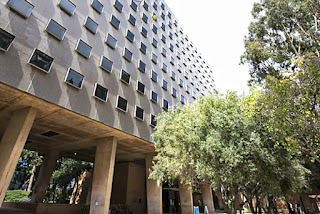 |
| Photo of the Meyer and Renee Luskin School of Public Affairs. Retrieved from https://philanthropy.ucla.edu/places/ |
The division between the studies of science and arts/humanities is well demonstrated in the architecture and naming scheme of buildings. For example, the north campus building above was named after two alumni and philanthropists, meanwhile:
 | ||
| Photo of the Math Sciences building. Retrieved from https://ww3.math.ucla.edu/math-town-hall-for-undergraduates-tuesday-october-20th/ the south campus building shown above was named after the concepts taught within it: separating the conceptual ideas and teachings from those that originally discovered them, while the north campus building gives credit to individuals that played significant roles in the development of the teachings or the development of the buildings (through donations and philanthropy). And, from an architectural basis, many buildings in UCLA's south campus have art to represent the teachings of the subjects; like the sigma in the Math Sciences building. However, it can be argued that, in buildings like the Luskin School of Public Affairs or Bunche Hall (pictured below), the design of the buildings demonstrate the different philosophies within humanities and art styles.
In C.P Snow's book, he pioneered and established the concept of separation between humanities (the literally intellectuals) and sciences (physical scientists) mentioned above. He argues that one of the main reasons for the divide between the two cultures is the lack of communication and understanding between them. Seeing the other culture as "opposition" only serves to cause further division between them. His last point is that the solution to ameliorating the divide between the two cultures is to develop a third culture that simultaneously utilizes and values the characteristics and teachings of both science and humanities. Following the ideas presented in this paper, Victoria Vesna further develops the notion of the third culture in her paper. She returns back to the idea of interdisciplinary spaces that Snow touched on as a partial, underutilized treatment. She says that these spaces offer good opportunities for communication and understanding between the two cultures, hopefully resulting in the third culture byproduct. At its core, the ideas presented by Snow and Vesna accurately describe the unity between applied social sciences, such as my personal major of Public Affairs, wherein hard data must be used to make subjective policy decisions. In this way, an open mind is instrumental to proper cooperation between the two cultures - which should lead to better societal outcomes. |





I think you bring up a really interesting point with your analysis of the architecture and naming conventions of the buildings on north and south campus. Most of my classes are in north campus and even though I walk through south campus every day to get to class, I never really noticed how many STEM buildings are named after their subjects rather than alumni and philanthropists.
ReplyDeleteAlso, I think you're right about the current relationship between the arts and sciences. It seems like most subjects in the arts and humanities rely on a basis of scientific knowledge and data that makes the two cultures pretty inseparable.